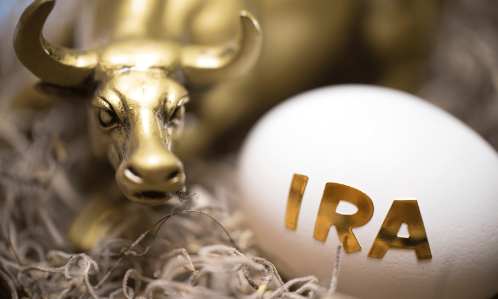
What is a Gold IRA: A Comprehensive Guide
In the world of finance, there’s a certain allure to gold. It’s been a symbol of wealth and power for centuries, and even today, it holds a unique place in our economy. But did you know that gold can also play a significant role in your retirement planning? Welcome to the world of Gold IRAs. Learn more about our Precious Metals IRA offering.
What is an IRA?
An Individual Retirement Account (IRA) is a tax-advantaged savings account designed for retirement savings in the United States. It lets you set aside pre-tax income, up to certain annual limits, for investments that can grow tax-deferred. But here’s the thing – not all IRAs are equal. There are several types of IRAs, including Roth IRAs, SEP IRAs, traditional IRAs, and SIMPLE IRAs. Each comes with its own set of rules and tax implications.
The Emergence of Gold IRAs
In the midst of these various IRA options, a new player has emerged: the Gold IRA. A Gold IRA, also known as a precious metals IRAs, is a self-directed IRA that allows you to invest in physical gold bullion, silver, platinum, and palladium. This type of IRA emerged following the Taxpayer Relief Act of 1997, which expanded the types of investments allowed in individual retirement accounts to include certain types of physical precious metals.
What is a Gold IRA?
A Gold IRA is a fantastic option for those looking to invest in physical gold and other approved precious metals. It’s a type of self-directed IRA that gives you the opportunity to diversify your portfolio and potentially grow your wealth.
Unlike other IRAs, a Gold IRA doesn’t hold paper assets like stocks or bonds. Instead, it holds physical bullion coins or bars. This unique feature offers a way to diversify your retirement portfolio and hedge against market volatility.
How Does a Gold IRA Work?
A Gold IRA operates much like a traditional IRA, but with a few key differences. One of the main differences is the role of the custodian. In a Gold IRA, the custodian must be a bank, credit union, trust company, or other entity approved by the IRS. This custodian is responsible for holding the physical gold in a secure depository and handling all the administrative duties of the IRA.
Types of Metals Allowed
Not all gold or precious metals are eligible for a Gold IRA. The IRS has specific requirements for the purity of the metals. For gold, it must be .995 fine or better. For silver, it must be .999 fine or better. Platinum and palladium must be .9995 fine or better. The metals must also be in the form of coins or gold bars and must be produced by a national government mint or accredited manufacturer.
Storage of Physical Gold
The physical gold in a Gold IRA must be stored in an IRS-approved depository. The custodian typically arranges for the storage on behalf of the IRA owner. The depository ensures the safety and security of the gold, and it must meet certain standards set by the IRS.
Types of Gold IRAs
When it comes to Gold IRAs, there are several types to choose from. Each comes with its own set of rules and tax implications. Understanding these differences can help you decide which type of Gold IRA is right for you.
Traditional Gold IRA
A Traditional Gold IRA operates much like a traditional IRA, but instead of investing in stocks, bonds, or mutual funds, you’re investing in gold and other approved precious metals. When it comes to a Traditional Gold IRA, not only are your contributions often tax-deductible, but the best part is that your earnings grow tax-deferred!
This allows you to witness the growth of your investment gains, free from tax concerns until you begin receiving retirement distributions. It’s a mutually beneficial arrangement for ensuring your future financial security.
Roth Gold IRA
A Roth Gold IRA, on the other hand, is funded with after-tax dollars. This means you pay taxes on your contributions upfront, but qualified distributions in retirement are tax-free. This can be a significant advantage if you expect to be in a higher tax bracket in retirement. Like a Traditional Gold IRA, a Roth IRA Gold IRA allows you to invest in gold and other approved precious metals.
SEP Gold IRA
A Simplified Employee Pension Gold IRA is a type of Gold IRA that’s designed for small business owners and self-employed individuals. It offers higher contribution limits than a Traditional or Roth Gold IRA, making it a good option for those who want to save more for retirement. Contributions to a SEP Gold IRA are tax-deductible, and the earnings grow tax-deferred.
SIMPLE Gold IRA
A SIMPLE (Savings Incentive Match Plan for Employees) Gold IRA is another type of Gold IRA designed for small businesses. It allows both the employer and the employee to contribute, with the employer required to make a matching or non-elective contribution. Like other Gold IRAs, a SIMPLE Gold IRA allows for investment in gold and other approved precious metals.
The Benefits of a Gold IRA

Investing in a Gold IRA comes with several potential benefits. These include diversification, a hedge against inflation, the potential for high returns, and tax advantages.
- Diversification: One of the main benefits of a Gold IRA is the opportunity for diversification. By incorporating gold and other precious metals into your retirement portfolio, you can effectively diversify beyond conventional assets such as stocks and bonds. This strategic approach helps mitigate risk and has the potential to enhance your overall investment returns.
- Hedge Against Inflation: Gold is often viewed as a hedge against inflation. This is because the price of gold tends to rise when the cost of living increases. By investing in a Gold IRA, you can potentially protect your retirement savings from the eroding effects of inflation.
- Potential for High Returns: Gold and other precious metals have the potential for high returns, especially during times of economic uncertainty. While past performance is no guarantee of future results, gold has historically performed well during market downturns.
- Tax Advantages: Similar to other IRAs, a Gold IRA brings remarkable tax advantages. Depending on the Gold IRA variant you opt for, you can relish tax-deductible contributions, tax-deferred growth, or even tax-free distributions during retirement. It’s a golden opportunity to maximize your financial benefits!
The Drawbacks of a Gold IRA
While Gold IRAs offer several benefits, they also come with certain drawbacks. It’s important to weigh these cons against the pros before deciding to invest in a Gold IRA.
Storage and Insurance Costs
One of the main drawbacks of a Gold IRA is the cost associated with storing and insuring the physical gold. In contrast to standard IRAs, Gold IRAs necessitate the physical storage of gold in an IRS-approved depository. These depositories charge fees for the storage and insurance of the gold, which can add up over time. In addition, Gold IRA custodial fees tend to be higher than regular IRA management fees.
Limited Liquidity
Gold is not a very liquid asset. This means it can be difficult to buy and sell quickly without affecting the price. While this may not be a significant issue for long-term investors, it can pose a challenge if you need to access your funds quickly.
Regulatory Risks
Gold IRAs are subject to a number of regulations. For example, not all types of gold are eligible for a Gold IRA. The IRS has specific requirements for the purity and form of the gold, and it must be stored in an IRS-approved depository. If these rules are not followed, you could face penalties.
Market Volatility
While gold can provide a hedge against inflation and market volatility, the price of gold itself can be quite volatile. This means the value of your Gold IRA can fluctuate, and there’s a risk you could lose money on your investment.
How to Set Up a Gold IRA
If you’ve weighed the pros and cons and decided to invest in a Gold IRA, the next step is to set it up. Here’s how:
Choosing a Custodian
The first step is to choose a custodian for your Gold IRA. The custodian is an IRS-approved financial institution that will handle the administrative duties of your IRA, including the storage and insurance of the physical gold. Many financial services and mutual fund gold IRA companies that handle regular IRAs do not offer self-directed IRAs, so you may need to choose a custodian that specializes in Gold IRAs.
Factors to Consider
When choosing a custodian, consider their fees, customer service, and reputation. You should also check whether they offer the type of gold investments you’re interested in. Some custodians may also offer additional services, such as assistance with gold purchases or help with Gold IRA rules and regulations.
Funding Your Gold IRA
Once you’ve chosen a custodian, the next step is to fund your Gold IRA. You can do this through a contribution, a transfer, or a rollover from a qualified plan. The contribution limits and distribution rules for a Gold IRA are the same as for a regular IRA.
- Direct Transfers: A direct transfer involves moving funds from one IRA to another. The gold mutual funds are sent directly from one custodian to another, so you never have access to the money. This type of transfer is not reported to the IRS and there are no tax implications.
- 60-Day Rollovers: Embarking on a 60-day rollover is like a financial relay race. You take the baton from one IRA, and sprint to another within 60 days, and if you make the smooth handoff, no tax hurdles to worry about. But beware, if you drop the baton and miss the deadline, taxes and penalties might trip you up. Stay agile and keep those rollovers on track!
Selecting Your Gold Investments
Once your Gold IRA is funded, you can select your gold investments. Remember, not all types of gold are eligible for a Gold IRA. The gold must meet IRS requirements for purity and form, and it must be produced by a national government mint or accredited manufacturer.
- Approved Precious Metals: In addition to gold, other precious metals are also eligible for a Gold IRA. These include silver, platinum, and palladium. Each of these metals must meet specific purity requirements set by the IRS.
- Bullion vs. Coins: Gold for a Gold IRA can be in the form of bullion or coins. Bullion is gold in its purest form, while coins can have other metals mixed in. Both bullion and coins must be produced by a national government mint or accredited manufacturer to be eligible for a Gold IRA.
Gold IRA Rules and Regulations

Investing in a Gold IRA comes with a unique set of rules and regulations. Understanding these rules can help you avoid potential pitfalls and make the most of your investment.
IRS Rules on Gold IRAs
The IRS has specific rules regarding the types of gold and precious metals you can invest in with a Gold IRA. Generally speaking, IRA-eligible gold must meet the following criteria:
Approved Precious Metals
- Have a fineness or purity of 99.5%
- Be produced by a national government mint or accredited manufacturer
- Be held by an IRA custodian in a secure depository
American Eagle coins are an exception to the purity rule. Despite being 91.67% pure, they are eligible for inclusion in a Gold IRA. For silver coins and bars, a purity of 99.9% is required, while platinum and palladium coins and bars must have a purity of 99.95%.
Storage Requirements
Did you know that the IRS has strict rules when it comes to precious metals? It’s a shame you can’t keep your shiny gold coins and bars at home or in a safety deposit box. Even if you just hold IRA-eligible gold and precious metals for a day, the IRS might see it as a distribution.
In certain situations, you could find yourself facing hefty penalties and taxes. That’s why it’s crucial to have a reliable gold IRA custodian who will smoothly transition your physical metals to a secure storage facility known as a depository.
Tax Implications
Like other IRAs, a Gold IRA offers tax advantages. However, there are also specific tax rules to be aware of.
Tax on Distributions
According to the IRS, you can’t take a distribution from your Gold IRA until you turn 59 ½. At that time, you’ll have to pay any income taxes due on any withdrawals, and you can liquidate the metals in your gold IRA account for cash or take physical possession of them without penalty.
Early Withdrawal Penalties
If you find yourself in need of accessing your funds before reaching the age of 59 ½, brace yourself for potential hurdles. You could face a 10% early withdrawal penalty, along with a 28% capital gains tax on any profits, should the value of your metals soar during your ownership of a Gold IRA. Stay vigilant and plan wisely!
However, there are specific circumstances where the 10% early withdrawal penalty does not apply, such as in the case of disability or when purchasing a home for the first time.
Gold IRA vs. Other Investment Options
When considering a Gold IRA, it’s important to compare it to other investment options. Here’s how a Gold IRA stacks up against stocks and bonds, real estate, and cryptocurrency.
Gold IRA vs. Stocks and Bonds
Unlike stocks and bonds, gold is a tangible asset that you can hold in your hand. This can provide a sense of security during times of economic uncertainty. However, gold does not produce income like stocks and bonds do through dividends and interest. It also has storage costs that stocks and bonds do not have.
Gold IRA vs. Real Estate
Like gold, real estate is a tangible asset. However, real estate can produce income through rent, and it also has potential tax advantages that gold does not have. On the downside, real estate can be difficult to sell quickly, and it comes with costs such as property taxes, maintenance, and insurance.
Gold IRA vs. Cryptocurrency
Cryptocurrency is a relatively new and highly volatile investment. While it has the potential for high returns, it also comes with a high level of risk. Unlike gold, cryptocurrency is not a physical asset, and it’s not backed by any government or commodity.
Conclusion
Investing in a Gold IRA can provide diversification, a hedge against inflation, and the potential for high returns. However, it also comes with drawbacks such as storage costs, limited liquidity, and regulatory risks. It’s important to weigh these pros and cons and consider your own financial situation and retirement goals before deciding if a Gold IRA is right for you.
Frequently Asked Questions
Can I hold gold in my existing IRA?
No, you cannot hold physical gold in a traditional IRA. You would need to open a self-directed Gold IRA to invest in physical gold.
What happens when I want to take a distribution from my Gold IRA?
When you take a distribution from your Gold IRA, you can choose to take it in cash or in physical gold. If you choose to take it in gold, the gold will be shipped to you.
Can I mix gold with other precious metals in my IRA?
Yes, in addition to gold, you can also hold silver, platinum, and palladium in a Gold IRA, as long as they meet the IRS requirements for purity and form.


